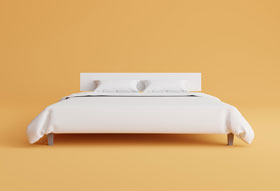Memory Foam Mattress - A Buyer's Guide in 2022

Some claim that memory foam mattresses offer the best night’s sleep. But what are they, and what makes them special in comparison to regular foam or sprung mattresses?
What is a memory foam mattress?
Memory foam is a type of foam that moulds to the body when in contact with body heat. It is a high-density, low resilience polyurethane foam that offers excellent orthopaedic support, yet springs back to its original shape when pressure is removed - hence the ‘memory’ name.
In addition to its comfort properties, memory foam is anti-microbial and therefore beneficial for those who suffer from allergies.
What is a memory foam mattress made of?
Memory foam is a specialist type of viscoelastic polyurethane foam that has been treated with various compounds and additives to give it its unique properties. Different volumes of additives influence the type of foam that is being manufactured. It is these chemical treatments that give memory foam its viscosity and present its famous ‘sinking’ feeling for the user.
Why are memory foam mattresses popular?
Memory foam mattresses are praised for their comfort. They help to reduce pressure on the spine and joints by conforming to the body. Its response to heat and bodyweight ensures that joints are supported, and the weight on various pressure points is reduced.
Advantages and disadvantages of a memory foam mattress
In addition to their excellent orthopaedic support qualities, memory foam mattresses typically suit all types of sleepers, are hypoallergenic, can be made with custom support requirements in mind, and often do not sag or sink. Furthermore, memory foam helps to prevent the transfer of motion. So, if you share a bed with someone who fidgets, chances are you won’t be disturbed.

That said, memory foam mattresses are a financial investment as they are more expensive than regular mattresses. They are also heavy and therefore tricky to move, and can give off a strange odour when new. Likewise, if you do not choose the correct firmness in line with your needs, you may find your memory foam mattress to be uncomfortable and unsupportive.
There are a few memory foam mattress types on the market, yet the two most popular are traditional memory foam, which we’ve covered above, and gel memory foam. Gel memory foam contains tiny gel beads that bond with the foam to encourage greater airflow. It's for this reason that gel memory foams are also advertised as ‘cool memory foam’ mattresses.
This variation of memory foam mattress also tends to be stronger, and many report that they do not sink into the bed unlike traditional memory foam. This is why gel memory foam is often preferred by those who have aching joints and require extra support.
How to choose the right density of memory foam mattress
Choosing a mattress density is usually determined by your bodyweight and your sleeping position. Higher densities are great for back and side sleepers, and for those who are heaver in weight. Low densities are brilliant for those who sleep on their front.
When choosing the density of your mattress, it’s important to remember that a high density doesn’t necessarily mean a greater firmness. The firmness of a mattress is measured by a number known as the Indentation Load Deflection (ILD).
Here at Easyfoam, we offer foam mattresses custom cut to your required size.
